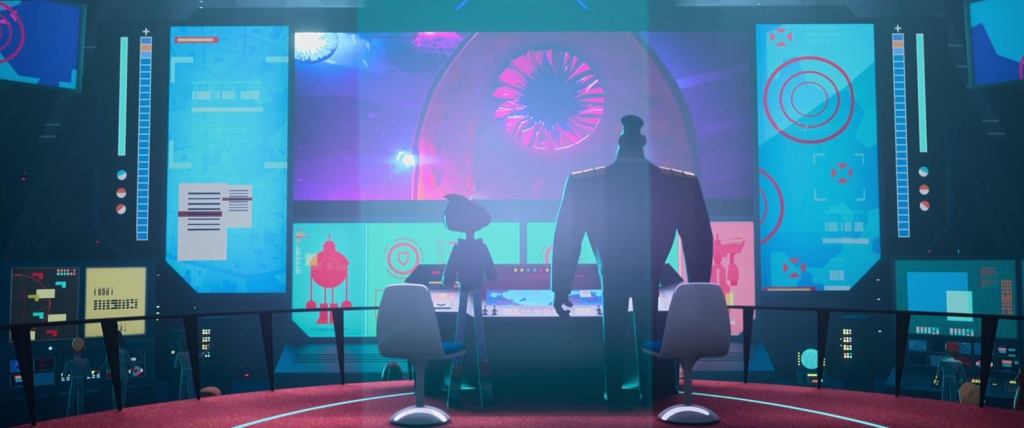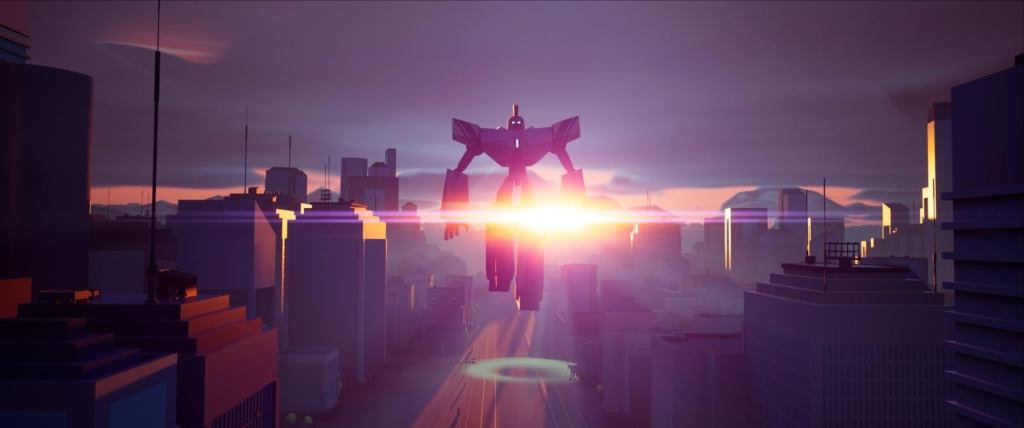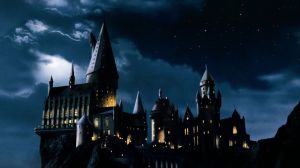Netflix is set to release the first 10-episode season of the 3D-animated action-comedy series Super Giant Robot Brothers this week on August 4th. As the name implies, it features giant robots that are siblings that must save the world from invading kaiju. However, Shiny (voiced by Eric Lopez) and Thunder (voiced by Chris Diamantopoulous) have vastly different personalities, and sometimes that creates its own kind of trouble. Ahead of the show’s release on the streaming platform, ComicBook.com had the opportunity to speak with director Mark Andrews (Brave) all about kaiju, virtual production sets, and what it takes for something new to really make its mark.
Videos by ComicBook.com
You can check out the logline for Super Giant Robot Brothers, straight from Netflix, below:
“Once the squabbling stops, the battling begins! Robot siblings Shiny and Thunder and their whiz inventor must defend Earth when space monsters attack.”
As noted above, Super Giant Robot Brothers is set to release its first 10-episode season on Netflix on August 4th. It was created by Victor Maldonado and Alfredo Torres, who also serve as executive producers alongside showrunner Tommy Blacha. Mark Andrews directed the series. It stars Eric Lopez as the voice of Shiny, Chris Diamantopoulous as the voice of Thunder, Marisa Davila as the voice of Alex Rose, Delbert Hunt as the voice of Creed, and more. The show was produced by Reel FX Animation Studios for Netflix. You can check out all of our previous coverage of Netflix in general right here.
What do you think about what Netflix has shown of Super Giant Robot Brothers so far? Are you looking forward to catching the first season on Netflix later this week? Let us know in the comments, or feel free to reach out and hit me up directly over on Twitter at @rollinbishop in order to talk about all things animation! And keep reading to check out our full interview with Andrews.
The following interview was lightly edited for clarity and length.
On How He Got Involved With Super Giant Robot Brothers

ComicBook.com: Your credited work is a laundry list of wildly popular animated movies, shorts, and TV series going back decades at this point. Perhaps most notably Brave, which won several prestigious awards. It seems fair to assume that you’re able to be a bit picky at this point. How did you first get involved with Super Giant Robot Brothers? What was it that appealed to you about it?
Mark Andrews: I was talking to Reel FX, I had a meeting looking for my next gig and we’re talking ideas, feature and episodic and stuff. And then they showed me this 3D test that they did of Super Giant Robot Brothers and also their pitch deck and I was just immediately taken by this rivalry between two brothers. I’m the oldest of three boys, so there was totally rivalry. That’s something that’s very universal. Whether it’s brother and brother, sister and sister, brother and sister, just rivalry of siblings is awesome. And then to put it in this Pacific Rim type of world where they have to fight kaiju all the time that are coming from a mysterious place, I was in. I was in immediately. All the things I love.
On Super Giant Robot Brothers’ Unusual Process

You touched on this a bit with your answer, but Super Giant Robot Brothers is a highly unusual animated show in terms of production, right?
Yeah.
Can you walk me through what that process of directing it actually looked like for you?
Right. So what we did is very new into the animation world, using a virtual production process, which is essentially… everything runs through the game engine. So we get to go onto the stage, a motion capture stage, and I have some actors and they’re the giant robots and all the other characters. And it’s a very live-action type of process, so it’s very fast, it’s very flexible, we can do whatever we want to do, and that gets all captured in the engine. And then you, what they call, publish it out to the other departments and animation gets it and they can throw out the motion capture, because it’s not like a Roberts Zemeckis, we’re not keeping the motion capture, the motion capture becomes the visual sketch of the scene. But everything is there, the context is there. I have some rudimentary special effects, I have the backgrounds there, I can see the characters, they can interact with their environment. I even get lighting right up top.
Usually, in a traditional animation pipeline, all these things come later. But this virtual pipeline brings everything up front, so as a storyteller and a filmmaker, I’m shooting with as much context that I’d never had before in a traditional animation pipeline. And then the animators go to town on it and they can stylize now, they can push whatever I’ve got to the umpteenth degree, and then it comes back into the engine for our final lighting and final special effects pass. So it’s really fast, really flexible, and I don’t have to wait. Being in the animation industry for as many years as I’ve been, it’s a slow-motion process. This is finally a process where you get all the best control from animation, what you’re able to do, with that energy and invention and discovery and improv that you have of live action. So it’s a great blend.
On Different Styles of Animation

One of the things that seem to constantly be in the conversation when animation comes up is the death of 2D, and the encroaching 3D, and now this is a whole new process itself. Do you feel in some ways that this is the bedrock, the future, of animation? Or is there room for everything in your opinion?
Well, I think there is room for everything because I think for filmmakers, it just comes down to a choice, right? Stylization. And I think audiences have been watching animation for years and years and years and years, and they like what they like, and they’ll be able to absorb and digest anything a filmmaker, a studio gives them. But I think with the advent of streaming where you take the pressures and the budgetary and financial weight off of some of these creators and the studios, that’s when you get things that are 2D or stop motion or whatnot. They can compete in this market and you don’t have to worry about $200 million budgets and having a box office opening weekend of $300 million or $200 million or whatnot.
On Pacific Rim and Other Influences

You mentioned Pacific Rim. What were some other influences on your work on this show?
Well, me and the showrunner, Tommy Blacha, we’re huge sci-fi nerds. And so Pacific Rim, giant kaiju, that all comes from our love of the monster movies that come out of Japan in the ’50s, your Godzillas, and your Gameras, and then there’s Ultraman, which we’re huge fans of. And so there was a lot of that from the Japanese television shows and action-movie circuits with the big monsters. Even some Power Rangers, when it comes to their villains, there’s this just fantastic – and I don’t want to use melodramatic as a bad term, but just dynamic, very arch kind of villains and stories that we loved. We’re huge fans of that, so a lot of our knowledge and love of that just got put right into the show where we could just use a lot of those as inspirational jumping-off points.
On What It Takes for Something New to Break Through

Now, as I’m sure you’re very much aware, these things are cyclical and all, but we live in a time of reboots and reimaginings and live-action adaptations of animated material. What does it take, in your opinion, for a truly new franchise, for Super Giant Robot Brothers, to break through these days?
I was very conscious of that. And animation has always been, if you look at designs of animation, it has been very round and soft for ages and ages and ages and ages, and I’m a huge manga and anime fan, so one thing that I wanted to do for this show is design my characters so they’re hard and sharp, it’s graphic. I wanted more of a comic book feel and a flat feel to the images so that if you freeze framed, it looks like it could be in a comic book, a highly graphic, highly designed kind of comic book. But I don’t want to sacrifice what I can do with these virtual cameras that’s much more along the lines of Michael Bay and Peter Jackson and the dynamics and the dynamism of my editing and my cinematography. So you get these two flavors. You get these very simplistic graphic comic book characters that are hard edge, which we haven’t seen in at least American animation for a long time.
But then you get at these highly sophisticated, highly complex cinematography and editing, and those two flavors just meshed really together and nobody’s going to have seen anything like it. And then the other thing is that being in the Unreal Engine, Epic’s Unreal Engine and on stage, it just allows me to shoot coverage like you would in live action and that gives animation editors for the first time even more control than usual, because they have so much footage to choose from. We were doing 12 hours of footage for a 22-minute animated short, right? So there’s a lot of stuff that ended up on the floor, but that gives us options. You don’t have that in animation. It’s very prescribed from the storyboards all the way through production, and everything is planned out.
It was a much more organic process than you get in animation. Animation is like, “I’m building it and this goes here and that goes there because it’s hard to do all this stuff.” With the Unreal Engine, it’s a lot faster and a lot easier to iterate, and so that leads us to a much more organic process at the end of the day. And so even when we were seeing our first edits off of the stage, before the animators touch it, before the lighting’s even done, these are exciting episodes, something that people hadn’t really seen and we had a lot of people that have been in animation for a while that were super excited. So now that they’re finished or polished off, we’ve probably seen all the stuff on it so far. It’s very, very, very different.
On What Ended Up on the Cutting Room Floor

Since you mentioned it, I have to ask, is there anything that ended up on the cutting room floor that maybe just didn’t quite work but you wish you had found a way to include it?
Well, my first episodes as we were rolling out from editorial were like 30- to 33-, 34-minutes long. So there’s a lot of ideas I had to drop out. So all of them landed at about 22, 25 minutes. So there’s about five-to-10 minutes that ended up on the floor, which are just more gags and milking of stuff. But I mean, not necessarily story structural things or ideas that were left on the floor, it’s more a lot more of the fun. We had a lot of fun that would just come out of that improvisation that would happen on the stage, we’d be working on the stage and either I would get an idea, or even my actors will get an idea, or we’re just playing around in between setups and we discover stuff that would just be serendipity.
And capturing is cheap like tape is cheap or film is cheap, and so we just got it all. Whether we were going to use it or not, that’s another story. But you don’t have that kind of flexibility in animation. So we have a lot, these are jam-packed, action-comedy episodes and there’s a lot to them. And some of it has to end up on the floor that I think the audiences would really love.
On the Most Important Question of All

Thank you again for agreeing to speak with me. I know I don’t have too much more time with you, so I did save my most important question for last.
Nice. All good.
Now, feel free to take your time and really think about this.
Yeah, yeah, yeah.
Are they super giant robot brothers, super giant robot brothers, super giant robot brothers, or super giant robot brothers?
That’s great. That’s a great question. That’s a hard one. I think there’s an exclamation point behind each one. It’s super! Giant! Robot! Brothers! Yeah.
Fair enough. That works.








